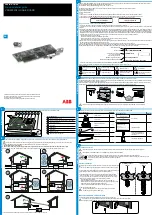
Section 7. Installation
215
splicing, measurements in a slow sequence may span across multiple-scan
intervals in the main program. When no measurements need to be spliced, the
slow-sequence scan will run independent of the main scan, so slow sequences
with no measurements can run at intervals
≤
main-scan interval (still in 1 ms
increments) without skipping scans. When measurements are spliced, checking
for skipped slow scans is done after the first splice is complete rather than
immediately after the interval comes true.
In sequential mode, all instructions in slow sequences are executed as they occur
in the program according to task priority.
Auto self-calibration is an automatic, slow-sequence scan, as is the watchdog task.
Read More
See
Auto Self-Calibration — Overview
(p. 99).
7.6.3.13.3 SubScan() / NextSubScan
SubScan()
/
NextSubScan
are used in the control of analog multiplexers (
Analog
Multiplexers — List
or to measure analog inputs at a faster rate than the
program scan.
SubScan()
/
NextSubScan
can be used in a
SlowSequenc /
EndSequence
with an interval of
0
.
SubScan
cannot be nested.
PulseCount
or
SDM measurement cannot be used within a sub scan.
7.6.3.13.4 Scan Priorities in Sequential Mode
Note
Measurement tasks have priority over other tasks such as
processing and communication to allow accurate timing needed within
most measurement instructions.
A priority scheme is used in sequential mode to avoid conflicting use of
measurement hardware. As illustrated in figure
Sequential-Mode Scan Priority
Flow Diagrams
(p. 217),
the main scan sequence has the highest priority. Other
sequences, such as slow sequences and auto self-calibration scans, must wait to
access measurement hardware until the main scan, including measurements and
processing, is complete.
Main Scans
Execution of the main scan usually occurs quickly, so the processor may be idle
much of the time. For example, a weather-measurement program may scan once
per second, but program execution may only occupy 250 ms, leaving 75% of
available scan time unused. The CR6 can make efficient use of this
interstitial-scan time to optimize program execution and communication control.
Unless disabled, or crowded out by a too demanding schedule, self-calibration
(see
Auto Self-Calibration — Overview
(p. 99))
has priority and uses some
interstitial scan time. If self-calibration is crowded out, a warning message is
issued by the CRBasic pre-compiler. Remaining priorities include
slow-sequence scans in the order they are programmed and digital triggers.
Following is a brief introduction to the rules and priorities that govern use of
interstitial-scan time in sequential mode. Rules and priorities governing pipeline
mode are somewhat more complex and are not expanded upon.
Summary of Contents for CR6 Series
Page 2: ......
Page 4: ......
Page 6: ......
Page 32: ......
Page 36: ......
Page 38: ......
Page 76: ...Section 5 Overview 76 FIGURE 20 Half Bridge Wiring Example Wind Vane Potentiometer ...
Page 80: ...Section 5 Overview 80 FIGURE 23 Pulse Input Wiring Example Anemometer ...
Page 136: ......
Page 454: ...Section 8 Operation 454 FIGURE 104 Narrow Sweep High Noise ...
Page 459: ...Section 8 Operation 459 FIGURE 106 Vibrating Wire Sensor Calibration Report ...
Page 535: ...Section 8 Operation 535 8 11 2 Data Display FIGURE 121 CR1000KD Displaying Data ...
Page 537: ...Section 8 Operation 537 FIGURE 123 CR1000KD Real Time Custom ...
Page 538: ...Section 8 Operation 538 8 11 2 3 Final Storage Data FIGURE 124 CR1000KD Final Storage Data ...
Page 539: ...Section 8 Operation 539 8 11 3 Run Stop Program FIGURE 125 CR1000KD Run Stop Program ...
Page 541: ...Section 8 Operation 541 FIGURE 127 CR1000KD File Edit ...
Page 546: ......
Page 552: ......
Page 610: ...Section 11 Glossary 610 FIGURE 137 Relationships of Accuracy Precision and Resolution ...
Page 612: ......
Page 648: ......
Page 650: ......
Page 688: ......
Page 689: ......
















































